
Wine Culture and Information since 2002 - Volume 22
 Wine Culture and Information since 2002 - Volume 22 |
|
Issue 106, April 2012 |
Contents |
|
|
The Moth and the Grape |
|
The life of a vintner would be too much boring in case he or she would only cultivate the vineyard, harvesting grapes and make wine. It would in fact be too simple - even boring - to just think about pruning vines, waiting for Nature to do its job, defoliating when needed, thinning grapes, harvesting and enjoying the wine he or she makes. Luckily, Nature as well as the intervention of man on natural balance of the environment, have always worked in order to make the life of vintner more exciting and thrilling. The vintner can in fact engage wars against parasites and vine diseases, in order not to get bored, sitting on a chair all the time while waiting for the grapes to properly ripe. Always being in a state of alert, always watching the vineyard - every single vine, every single leaf and grape - in order not to miss every signal in time therefore avoiding the worse. And he or she must act quickly, provided it is not too late. Nature, everyone knows, is sometimes insidious: many living beings, practically all of them, have their natural enemies that, in fighting for survival, try to take advantage of others in order to ensure the survival of their own species. Mors tua, vita mea (your death, my life) reads a famous saying of ancient times. The organism subject of the attack has two possibilities: succumbs to the fury of the attacker or develops defense strategies in order to avoid the worse. Sometimes the enemies of the enemies give a help, bringing to the significant result of saving - as a side effect - the species subject to the attack. Developing specific defenses is evidently more complex, not always possible, sometimes fruit of an environmental adaptation which can bring to a change of the structure and biological functions. A never ending fight among beings which make everything in order to survive, even at the cost of taking advantage or defeating other species. By paraphrasing a famous cue of the movie “Deadline - U.S.A.” said by Humphrey Bogart playing the character of Ed Hutcheson: That's Nature, baby!. Not only Nature. Sometimes man do its part and, in its delirium of omnipotence - voluntary or not - modifies some natural balances, frequently causing remarkable damages and endangering the survival of many species. It happened for many animals and plants, the vine - of course - was not saved by these interferences. We can think of phylloxera, for example, introduced by man to Europe causing huge damages to the vineyards of the Old Continent. The introduction of phylloxera certainly was accidental, even though the fearful aphid was unknown in its homeland - North America - and it found completely defenseless the roots of Vitis Vinifera. The first “mysterious” effects were recorded in France in 1863, spreading in few tens of years all over Europe, seriously menacing the survival of vineyards. Today the phylloxera is found in all the wine making countries of the world, bringing to a radical change of vine cultivation. Just like phylloxera, the new menace for European vineyards comes from North America. It should be said, for the sake of truth, it is not lethal like phylloxera, but however causes remarkable damages to the vine. This time is not an aphid but a small bug belonging to the family of moths. Its scientific name is Antispila Oinophylla and it is a vine's leaf “miner”, causing its destruction. The name itself, as a matter of fact, is very clean on what this moth is doing: Oinophylla comes from the Greek terms oinos, that is “wine” and phylla, that is “leaves”, because its larvae are being deposited and live in vine leaves. Antispila Oinophylla was discovered for the first time in Italy, in the North-East area of the Country, in particular in Veneto and Trentino Alto Adige. This moth was unknown in its home land, a factor which considerably delayed its identification. The small moth has caused many troubles to the vintners of these areas and, it seems, it is now spreading in Lombardy, in the area of Brescia, therefore in Franciacorta. To deprive a plant of its leaves, vine is no exception, means deeply affecting its biological activity. The identification of this moth required a remarkable effort of many research institutes. The research and identification was done by professors Mario Baldessari and Gino Angeli of Edmun Mach Foundation of Istituto Agrario San Michele all'Adige; Vicenzo Girolami, Carlo Duso and Luca Mazzon of University of Padua, Department of Environmental Agronomy and Crop Science; Erik J. Van Nieukerken and Camiel Doorenweerd of Netherlands Centre for Biodiversity; David L. Wagner of University of Connecticut, Department Ecology & Evolutionary Biology. The results of this important research have been published on the online magazine ZooKeys. This moth - just 3 millimeters long and with a wingspan of six - having a preference for Chardonnay, Cabernet Sauvignon and Muscat Blanc vines, could also spread in other areas of the Country. According to researchers who have been successful in identifying and studying it, the remedy to this moth - luckily - seems to be natural. it in fact seems that the only remedy to fight Antispila Oinophylla are parasitic wasps, which would become their natural enemies useful to limit their proliferation. How this moth arrived to Italy however remains a mystery: the most supported hypothesis is that it was transported with goods from North America, not necessarily associated to agriculture or viticulture. The “damage” is however made and we now have to find a remedy before it is too late. We just have to wish the remedy will not have side effects which could cause other damages, not only to vines, but also and in particular to environmental balance and its respect. We just have to wait for the precious job of experts. Antonello Biancalana
|
||||
Sulfur Dioxide in TastingWidely used in enology, however present in wine, sulfur dioxide affects organoleptic quality of wine, from appearance to taste |
|
Wine and chemistry are among the most debated subjects of the world of wine. In particular by consumers who, legitimately, are concerned about the genuineness of what they pour in their glasses. Sometimes we forget wine is, in any case, the result of a complex chemical process in which the many elements making it undergo radical changes, however essential for the making of the beverage of Bacchus. In other words, Nature makes use of chemistry to transform grape juice into wine. Frequently, this is undeniable, man does the same to control certain processes and to shape the wine in order to give it specific qualities and characteristics. We should remember the natural process of vinification is to transform grape juice into vinegar: man makes use of technology and chemistry in order to avoid this unhappy end. The need of controlling the vinification process does not however justify the abuse of chemistry and technology. The limit is not always defined by the good sense of the one making use of it, but also by the respect for those who want to drink wine with awareness without side effects for their health. Last but not the least, respect for vine, grape, wine and the millenary culture and tradition they represent. Making a wine with the least number of faults is of course desirable and a fault, no matter it is “natural” or not, is however a fault lowering the quality of wine. On this regard it should be remembered, in order to reach this goal, it is however and always indispensable the quality of the raw matter: grape. If it is true from a quality grape it can be produced a great quality wine, from bad quality grapes it can be obtained - in the best case and thanks to the skill of the wine maker - a mediocre wine. The difference between a good wine maker and a less good one, it is not what he or she can make in the winery, indeed what he or she can obtain from the vineyard, alone or with the fundamental help of the agronomist. Among the many helps used for the production of wine, the most used one certainly is sulfur dioxide. Not only the chemical element mainly used in enology, but also the most debated one. Using the least possible quantity of sulfur dioxide in wine certainly is wished - and when this happens, the result can be greatly appreciated in the glass - and it should be said that completely eliminating its use in enology is virtually impossible. Nature, with its goodness, adds sulfur dioxide to wine during fermentation, as this simply is a byproduct of the activity of yeast. Of course it is a lower quantity than what man - by law or by need - adds to the must or to the wine during production. In other words, a wine without sulfur dioxide - or simply, with no sulfites - cannot exists. It can of course be limited its use, but it is not however possible to completely eliminate it from wine. Sulfur dioxide, no matter how it is being used, allows wine makers to stabilize the wine, to avoid the development of certain faults, including oxidation. It should also be noticed sulfur dioxide is widely used in food industry, sometimes used in a higher quantity than what is permitted by law in wine. According to European laws currently in force, the maximum quantity of sulfur dioxide which can be used for the production of wine is 150mg/l for red wines and 200 mg/l for white and rose wines. The maximum quantity permitted in sweet wines is quite higher, currently set to 400mg/l. It should be noticed these represent the maximum permitted quantity: in most of the cases the quantity of sulfur dioxide found in wines is lower. Finally, it must be said sulfur dioxide is not however healthy for man and, in certain cases, it can cause important allergies in subjects particularly sensitive to this gas.
On this regard, it should be noticed the World Health Organization (WHO) has recommended a maximum daily intake of sulfur dioxide of 0.7mg per kilogram of body weight. A quick calculation and considering a male subject with a 80 kilogram of weight, the maximum daily intake equals to 56 milligrams. This means that, in case in a white wine has been used the maximum quantity set by law, half a bottle of wine - 375 milliliters - is enough to exceed the maximum daily intake. Wine and, not to forget, drinks and foods containing low quantity of sulfur dioxide are healthier and should however be preferred. Talking about limits, an intake of 1.5 grams of sulfur dioxide for kilogram of body weight is considered by World Health Organization as lethal. In particularly sensitive subjects, sulfur dioxide can cause migraine as well as disorders and allergic reactions. Sulfur dioxide easily bounds with oxygen and this is one of the reason why it is being used in enology, therefore avoiding the oxidation of wine. In case the quantity of sulfur dioxide can be of concern for the health, therefore wishing to get the least possible quantity, its predilection for oxygen can certainly be useful. In fact, by oxygenating the wine before consumption, the quantity of sulfur dioxide can considerably be lowered. The quickest and most effective way is to swirling the glass - by allowing the wine to wet the broader possible surface - an operation which can also free 30-40% of sulfur dioxide contained in a wine, as well as favoring a better development of aromas. The same result can be obtained by decanting a wine - a “traumatic” operation to be done only in case a sediment is present - whereas it is completely useless uncorking a bottle some hours before consumption. The reasons why sulfur dioxide is used in enology are many. It has an antiseptic effect, therefore added to the must it works a selection of bacteria and yeast by eliminating the least resistant ones while ensuring, at the same time, a better stability. The antiseptic action of sulfur dioxide therefore works a selective action on yeast which will ferment the must, while remembering that - in general terms - bacteria are less resistant to this gas than yeast. Sulfur dioxide is useful during the decanting of the must, as it can delay the activity of yeast, therefore preventing the start of fermentation while favoring the decanting of solid parts. It favors a better extraction of coloring substances in red grapes thanks to its property of making the skins more permeable. Finally, as already said, it has a very good antioxidant effect thanks to its property of easily bound with oxygen, therefore avoiding its bond with the substances of must and wine. Sulfur dioxide can be added to the wine and must in different ways. The most traditional and old method - as well as the least controllable one in terms of quantity actually added - consists in burning a tablet of sulfur inside the container which will be used for wine or must. The burning of sulfur produces, in fact, sulfur dioxide. Modern enology, in order to rigorously control the quantity of added gas, makes use of other methods, of which the most common one consists in using potassium metabisulfite. This substance, having the aspect of white salt, when it gets in contact with the must or wine produces sulfur dioxide in a quantity of about 0.55 grams per each added gram. Other methods of adding sulfur dioxide make use of liquid solutions or cylinders containing this gas that, it should be noticed, is colorless however easily recognizable for its characteristic pungent smell. For the sake of a better information, it should be said in recent times they are trying to find alternatives to the use of sulfur dioxide in enology, not only by limiting quantity, but also by completely avoiding its use. Some of these alternative attempts have produced very promising results that make us think of a wine making future without adding sulfur dioxide, while remembering - in any case - this gas is however produced during vinification. Wines produced with these techniques are now available in the market, usually emphasizing in the label they are wines with no sulfites: indeed it would be more correct saying they are wines “with no added sulfites”. The quantity of sulfur dioxide produced during vinification is however lower than every possible adding done for wine making purposes and the production of a wine with no added sulfites certainly is wished, last but not the least, for the lower effects on health. According to an organoleptic point of view, sulfur dioxide can drastically change every sensorial aspect of wine. Some effects certainly are positive, whereas others are completely negative, effects which generally happens with its bad use, in particular with the excess. In case it is properly used - and this does not mean using it at the maximum quantity set by law, and however using a far lower quantity - it gives the wine a better stability over time. Recognizing sulfur dioxide in wines is very simple, in particular to the nose: when used in excess or improperly, it will always be perceived the unpleasant and typical smell of sulfur which tends to cover everything else. Excessive quantity of sulfur dioxide also produces an accumulation of acetaldehyde that, when ingested, causes disorders for the health and it is also more toxic than ethyl alcohol. Moreover, the excess of sulfur dioxide causes the formation of hydrogen sulfide and mercaptans, giving the wine an unpleasing aroma of garlic and rotten eggs. The preservative effect of sulfur dioxide ensures the wine a longer life, in particular for its antioxidant effect, therefore preventing the alteration of aromas and of taste with typical oxidized characters. Talking about wine's appearance, sulfur dioxide stabilizes color, in particular in red wines, therefore favoring the extraction from the skin during maceration and fermentation. The aroma of wines properly treated with sulfur dioxide is generally “finer” thanks to its selective effect on yeast and bacteria, therefore allowing a more regular and controllable fermentation. The correct use of sulfur dioxide also reduces the quantity of volatile acidity - which can be perceived with a more or less intense aroma of vinegar - thanks to its antiseptic action against acetic bacteria. Antiseptic and antioxidant effects, in case this gas is properly used, allow a longer keeping of the original aromas of wine. Finally, during its volatilization, sulfur dioxide helps the perception of certain fruit aromas. The excess of sulfur dioxide - according to the sensitivity for this gas, in some subjects already perceivable in a quantity of 20-30mg/l - gives the wine a sulfurous flavor, hiding the aromatic and gustatory qualities of wine. The correct use of sulfur dioxide improves the taste of wine, not because of its organoleptic characteristics, indeed for its preservative effect, preventing oxidation and the development of bacteria. Finally, it should be noticed European laws requires the indication in label of the mention “contains sulfites” in all the wines in which the content of sulfur dioxide is higher than 10mg/l. This mention is virtually found in every wine, also in those produced with no added sulfur dioxide, as yeast, during fermentation and according to the type, can produce a variable quantity of this gas from 6 to 40 mg/l. In this sense - and unjustly - law makes no distinction between a wine produced with no added sulfur dioxide and one containing the maximum quantity permitted by law, that is 200mg/l for white and rose wines, 150mg/l for reds.
|
||||||||||||
Wines of the Month |
|
|
|
Score legend Prices are to be considered as indicative. Prices may vary according to the country or the shop where wines are bought |
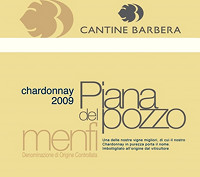
|
|
Menfi Chardonnay Piana del Pozzo 2009 |
|
| Cantine Barbera (Sicily, Italy) | |
| Grapes: Chardonnay | |
| Price: € 12.00 | Score: |
| Menfi Chardonnay Piana del Pozzo shows a pale golden yellow color and nuances of straw yellow, very transparent. The nose reveals intense, clean, pleasing and refined aromas that start with hints of apple, banana and grapefruit followed by aromas of pear, hawthorn, hazelnut, vanilla, honey and plum. The mouth has good correspondence to the nose, a crisp attack and however balanced by alcohol, good body, intense flavors, pleasing roundness. The finish is persistent with flavors of apple, banana and grapefruit. Part of Menfi Chardonnay Piana del Pozzo ferments in barrique. | |
| Food Match: Stuffed pasta, Roasted white meat, Roasted fish | |
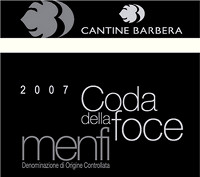
|
|
Menfi Rosso Coda della Foce 2007 |
|
| Cantine Barbera (Sicily, Italy) | |
| Grapes: Nero d'Avola (40%), Petit Verdot (40%), Merlot (20%) | |
| Price: € 16.00 | Score: |
| Menfi Rosso Coda della Foce shows an intense ruby red color and nuances of garnet red, little transparency. The nose denotes intense, clean, pleasing and refined aromas that start with hints of blackberry, black currant and plum followed by aromas of black cherry, dried violet, blueberry, vanilla, chocolate, tobacco and menthol. The mouth has good correspondence to the nose, a properly tannic attack and however balanced by alcohol, good body, intense flavors, pleasing roundness. The finish is persistent with flavors of blackberry, black currant and plum. Menfi Rosso Coda della Foce ages for 16 months in cask and barrique followed by 8 months of aging in bottle. | |
| Food Match: Stewed and braised meat, Roasted meat, Hard cheese | |
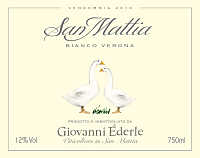
|
|
San Mattia Bianco 2010 |
|
| Giovanni Ederle (Veneto, Italy) | |
| Grapes: Garganega (60%), Chardonnay (40%) | |
| Price: € 6.00 | Score: |
| San Mattia Bianco shows a brilliant greenish yellow color and nuances of greenish yellow, very transparent. The nose denotes intense, clean and pleasing aromas which start with hints of apple, pear and banana followed by aromas of tangerine, peach and broom. The mouth has good correspondence to the nose, a crisp attack and however balanced by alcohol, however balanced by alcohol, good body, intense flavors. The finish is persistent with flavors of apple, pear and peach. Part of the Chardonnay ages in cask. | |
| Food Match: Fried fish, Pasta and risotto with crustaceans and fish, Sauteed fish | |
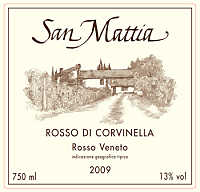
|
|
San Mattia Rosso di Corvinella 2009 |
|
| Giovanni Ederle (Veneto, Italy) | |
| Grapes: Corvina, Corvinone (60%), Rondinella (40%) | |
| Price: € 10.00 | Score: |
| San Mattia Rosso di Corvinella shows a brilliant ruby red color and nuances of ruby red, moderate transparency. The nose reveals intense, clean, pleasing and refined aromas that start with hints of plum, blackberry and black cherry followed by aromas of dried violet, vanilla, raspberry, carob and mace. The mouth has good correspondence to the nose, a properly tannic attack and however balanced by alcohol, good body, intense flavors, agreeable. The finish is persistent with flavors of plum, blackberry and black cherry. Part of San Mattia Rosso di Corvinella ages in cask. | |
| Food Match: Stuffed pasta, Sauteed meat, Broiled meat and barbecue | |
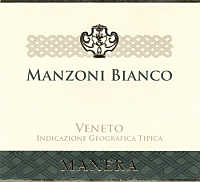
|
|
Manzoni Bianco 2010 |
|
| Manera (Veneto, Italy) | |
| Grapes: Manzoni Bianco | |
| Price: € 3.70 | Score: |
| This Manzoni Bianco shows a brilliant greenish yellow color and nuances of greenish yellow, very transparent. The nose denotes intense, clean and pleasing aromas which start with hints of apple, pear and citrus fruits followed by aromas of pineapple, hawthorn and broom. The mouth has good correspondence to the nose, a crisp attack and however balanced by alcohol, good body, intense flavors. The finish is persistent with flavors of apple, pear and pineapple. This Manzoni Bianco ages in steel tanks. | |
| Food Match: Pasta and risotto with fish and crustaceans, Fried fish, Sauteed fish | |

|
|
Antico Girone 2008 |
|
| Manera (Veneto, Italy) | |
| Grapes: Refosco dal Peduncolo Rosso | |
| Price: € 8.56 | Score: |
| Antico Girone shows a deep ruby red color and nuances of garnet red, little transparency. The nose denotes intense, clean, pleasing and refined aromas that start with hints of black cherry, blackberry and plum followed by aromas of blueberry, violet, raspberry, vanilla, chocolate and menthol. The mouth has good correspondence to the nose, a tannic attack and however balanced by alcohol, pleasing roundness. The finish is persistent with flavors of black cherry, plum and blackberry. Antico Girone ages for 12 months in cask. | |
| Food Match: Broiled meat and barbecue, Roasted meat, Stewed meat | |

|
|
Trento Talento Dosaggio Zero 2008 |
|
| Letrari (Trentino Alto Adige, Italy) | |
| Grapes: Chardonnay (85%), Pinot Noir (15%) | |
| Price: € 21.80 | Score: |
| Trento Talento Dosaggio Zero shows a brilliant golden yellow color and nuances of golden yellow, very transparent, fine and persistent perlage. The nose reveals intense, clean, pleasing, refined and elegant aromas that start with hints of banana, hazelnut and bread crust followed by aromas of apple, acacia, yeast, plum, pear, honey and hawthorn. The mouth has good correspondence to the nose, an effervescent and crisp attack, however balanced by alcohol, good body, intense flavors, pleasing roundness. The finish is persistent with flavors of banana, apple and hazelnut. Trento Talento Dosaggio Zero referments in bottle for at least 24 months. | |
| Food Match: Pasta and risotto with fish and crustaceans, Broiled crustaceans, Fried fish | |

|
|
Trento Talento Brut Riserva 2007 |
|
| Letrari (Trentino Alto Adige, Italy) | |
| Grapes: Chardonnay (60%), Pinot Noir (40%) | |
| Price: € 24.30 | Score: |
| Trento Talento Brut Riserva shows a brilliant golden yellow color and nuances of golden yellow, very transparent, fine and persistent perlage. The nose denotes intense, clean, pleasing, refined and elegant aromas which start with hints of apple, banana and bread crust followed by aromas of acacia, plum, pear, yeast, grapefruit, broom, hawthorn, praline and butter. The mouth has excellent correspondence to the nose, an effervescent and crisp attack, however balanced by alcohol, good body, intense flavors, pleasing roundness. The finish is very persistent with long flavors of banana, apple and plum. Trento Talento Brut Riserva referments in bottle on its lees for at least 36 months. | |
| Food Match: Stuffed pasta, Roasted white meat, Roasted fish, Fish soups | |
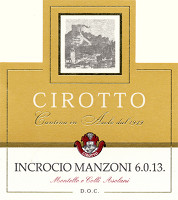
|
|
Montello e Colli Asolani Manzoni Bianco 2010 |
|
| Cirotto (Veneto, Italy) | |
| Grapes: Manzoni Bianco | |
| Price: € 8.90 | Score: |
| Montello e Colli Asolani Manzoni Bianco shows a pale straw yellow color and nuances of greenish yellow, very transparent. The nose denotes intense, clean, pleasing and refined aromas that start with hints of apple, pear and pineapple followed by aromas of hawthorn, plum, citron and broom. The mouth has good correspondence to the nose, a crisp attack and however balanced by alcohol, good body, intense flavors, pleasing roundness. The finish is persistent with flavors of apple, pear and citron. Montello e Colli Asolani Manzoni Bianco ages in steel tanks. | |
| Food Match: Pasta and risotto with fish and crustaceans, Mushroom soups, Sauteed fish | |
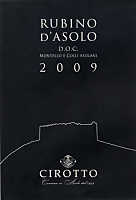
|
|
Montello e Colli Asolani Rosso Superiore Rubino d'Asolo 2009 |
|
| Cirotto (Veneto, Italy) | |
| Grapes: Cabernet Sauvignon, Merlot, Cabernet Franc, Petit Verdot | |
| Price: € 19.60 | Score: |
| Montello e Colli Asolani Rosso Superiore Rubino d'Asolo shows an intense ruby red color and nuances of ruby red, little transparency. The nose denotes intense, clean, pleasing and refined aromas which start with hints of black currant, black cherry and blueberry followed by aromas of bell pepper, plum, violet, vanilla, cocoa and mace. The mouth has good correspondence to the nose, a tannic attack and however balanced by alcohol, good body, intense flavors, agreeable. The finish is persistent with flavors of black currant, black cherry and blueberry. Montello e Colli Asolani Rosso Superiore Rubino d'Asolo ages in cask for more than 18 months. | |
| Food Match: Roasted meat, Broiled meat and barbecue, Stewed meat with mushrooms | |
News |
|
In this section are published news and information about events concerning the world of wine and food. Whoever is interested in publishing this kind of information can send us a mail to our address.
|
AquavitaeReview of Grappa, Distillates and Brandy |
|
|
| Distillates are rated according to DiWineTaste's evaluation method. Please see score legend in the "Wines of the Month" section. |
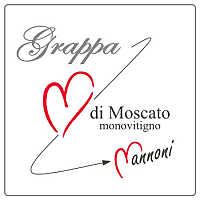
|
|
Grappa Cuore di Moscato |
|
| Nannoni (Tuscany, Italy) | |
| Raw matter: Pomace of Muscat Blanc | |
| Price: € 49,00 - 500ml | Score: |
| This grappa is limpid, colorless and crystalline. The nose denotes intense, clean, pleasing and refined aromas of grape, pear, apple, banana, hazelnut and sage, with almost imperceptible alcohol pungency. In the mouth has intense flavors with perceptible alcohol pungency which tends to dissolve rapidly, good correspondence to the nose, pleasing roundness, balanced sweetness. The finish is persistent with flavors of grape, pear and banana. This grappa is distilled in a batch steam operated alembic still. Alcohol 42%. | |
Wine Parade |
|
|
| The best 15 wines according to DiWineTaste's readers. To express your best three wines send us an E-mail or fill in the form available at our WEB site. |
| Rank | Wine, Producer | |
|---|---|---|
| 1 |
| Brunello di Montalcino 2006, Siro Pacenti (Italy) |
| 2 |
| Barolo Cannubi Boschis 2005, Sandrone (Italy) |
| 3 |
| Batàr 2008, Querciabella (Italy) |
| 4 |
| Brunello di Montalcino Vigneto Manachiara 2005, Tenute Silvio Nardi (Italy) |
| 5 |
| Rosso Conero Riserva Grosso Agontano 2007, Garofoli (Italy) |
| 6 |
| Collio Sauvignon Ronco delle Mele 2010, Venica (Italy) |
| 7 |
| Gran Masetto 2007, Endrizzi (Italy) |
| 8 |
| Arkezia Muffo di San Sisto 2004, Fazi Battaglia (Italy) |
| 9 |
| Franciacorta Pas Dosé Récemment Dégorgé 2006, Cavalleri (Italy) |
| 10 |
| Adarmando 2009, Tabarrini (Italy) |
| 11 |
| Confini 2007, Lis Neris (Italy) |
| 12 |
| Sagrantino di Montefalco Collepiano 2007, Arnaldo Caprai (Italy) |
| 13 |
| Trento Brut Riserva Methius 2004, Dorigati (Italy) |
| 14 |
| Aglianico del Vulture Il Repertorio 2006, Cantine del Notaio (Italy) |
| 15 |
| Avvoltore 2009, Moris Farms (Italy) |
| |||||||
Privacy Policy | |||||||


| Copyright © 2002-2024 Antonello Biancalana, DiWineTaste - All rights reserved |
| All rights reserved under international copyright conventions. No part of this publication and of this WEB site may be
reproduced or utilized in any form or by any means, electronic or mechanical, without permission in writing from DiWineTaste. |